The Allegheny River is a long body of water winding through the eastern United States. Nestled in the Appalachian region, this river meanders mainly in Pennsylvania, serving as a vital tributary to the mighty Ohio River.
Its headwaters originate in the Allegheny Mountains of Pennsylvania, and from there, it embarks on a journey that weaves through picturesque landscapes, diverse ecosystems, and a rich tapestry of human history.
Keep reading to learn about the river’s length and other characteristics.
Where Does the Allegheny River Start?
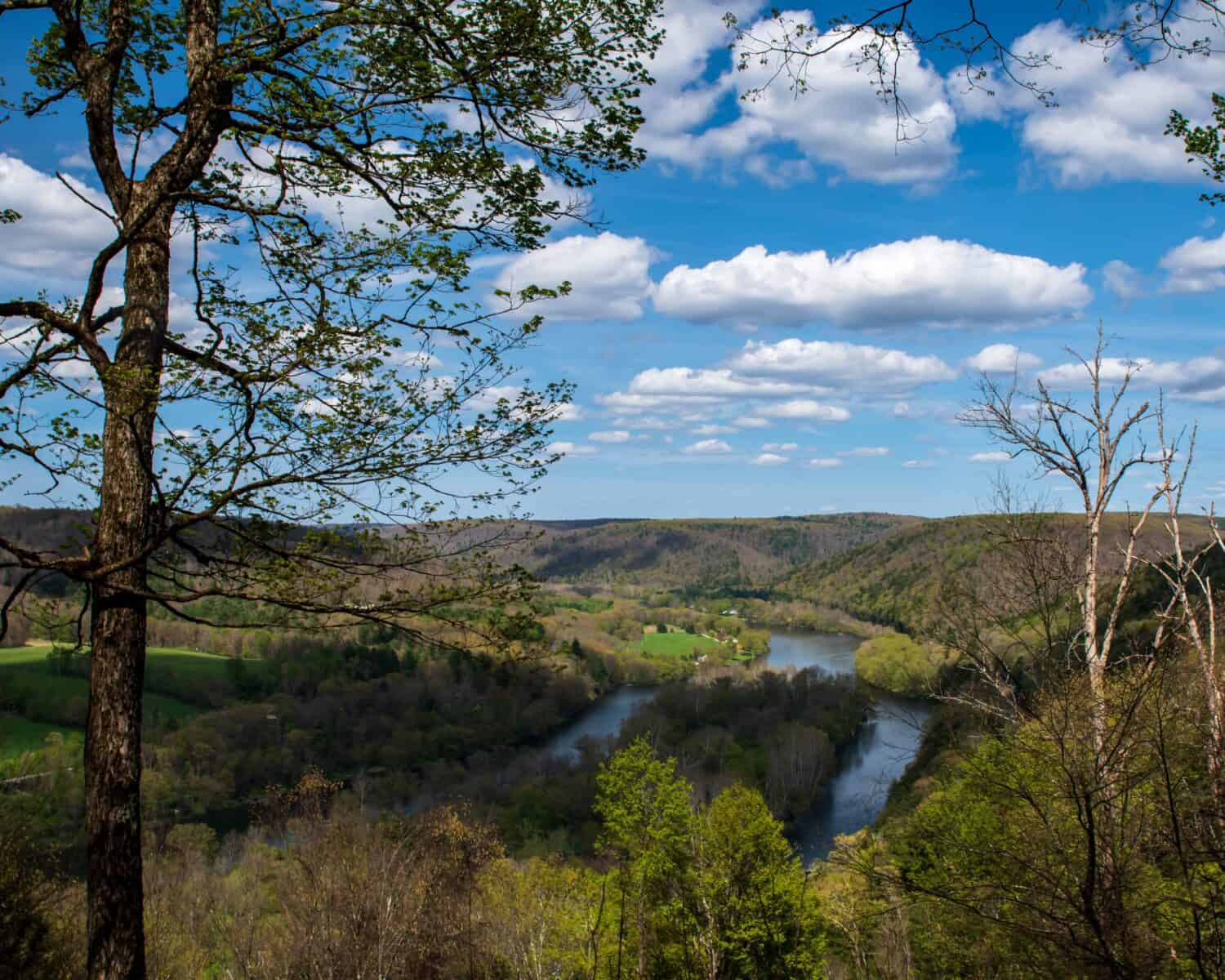
Numerous small streams create the Allegheny River’s headwaters.
©woodsnorthphoto/Shutterstock.com
The Allegheny River originates in north-central Pennsylvania, specifically in Potter County. Its headwaters begin near the town of Coudersport, which is situated in the Allegheny Plateau region of the state. Specifically, the headwaters start close to Ben Green and Cobb Hill Roads.
From this point, the river flows southwestward, gathering water from numerous small streams and tributaries as it begins its journey toward the Ohio River.
At the start, the Allegheny River is just a tiny, foot-wide stream meandering through a field of grasses and wildflowers. Along Highway 49, near the village of Raymond, a historic marker recalls the beginning of this river.
How Long Is the Allegheny River?
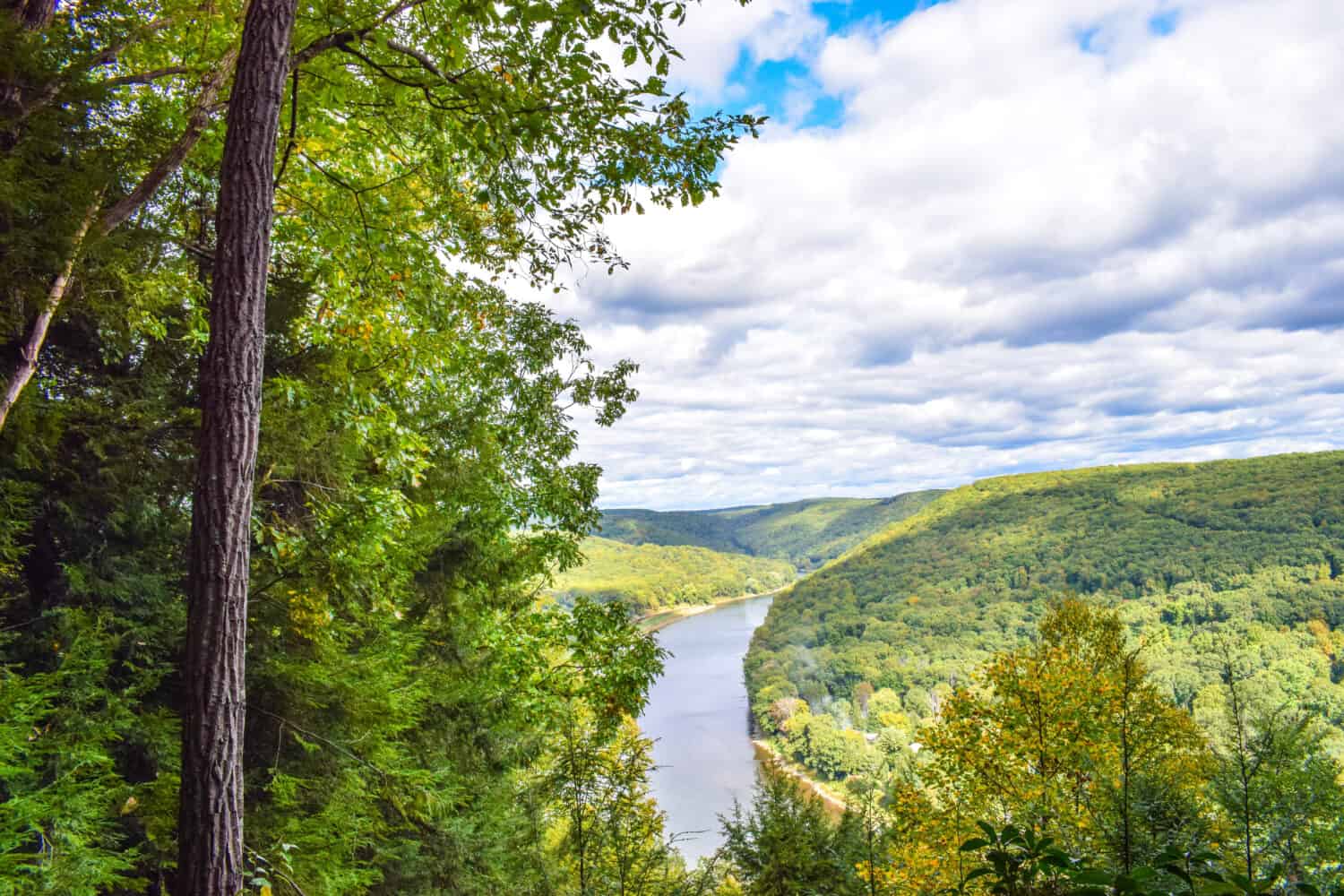
The Allegheny River is the third-longest in Pennsylvania after the Ohio and Susquehanna Rivers.
©K Steve Cope/Shutterstock.com
The Allegheny River is approximately 325 miles (523 kilometers) long. The river starts its course from Potter County, PA, in the heart of the Allegheny Plateau. This geological feature with rolling hills and deep ravines provides a stunning backdrop for the river’s course.
Along its course, the Allegheny River meanders through diverse landscapes. It flows through pristine forests, mountainous terrain, and picturesque valleys in its upper reaches.
After leaving its headwaters, the river journeys northward, crossing into the southwest part of New York. This portion is known for its scenic beauty. The river is impounded in Pennsylvania by the Kinzua Dam, close to the border with New York. This results in the large Allegheny Reservoir, situated across both states.
Along its course, the river has eight locks and fixed-crest dams, creating reservoirs. Those were built in the early 20th century to make the river navigable upstream between Pittsburgh and East Brady.
After crossing back to Pennsylvania, the Allegheny flows southwestward. The river travels next to more than 75 small communities and villages like Franklin, Kittanning, Oil City, Warren, etc.
After a journey of 325 miles, the Allegheny River arrives in Pittsburgh, PA.
How the Allegheny River Length Compares to Other Rivers
While the Allegheny River is iconic, it remains a small river compared to the longest in the United States and Canada.
| Name | Length (Miles) |
|---|---|
| Missouri River | 2,341 |
| Mississippi River | 2,340 |
| Rio Grande | 1,896 |
| Colorado River | 1,450 |
| Columbia River | 1,243 |
| Snake River | 1,078 |
| Tennessee River | 652 |
| Potomac River | 405 |
| Allegheny River | 325 |
| Hudson River | 315 |
Where Does the Allegheny River End?
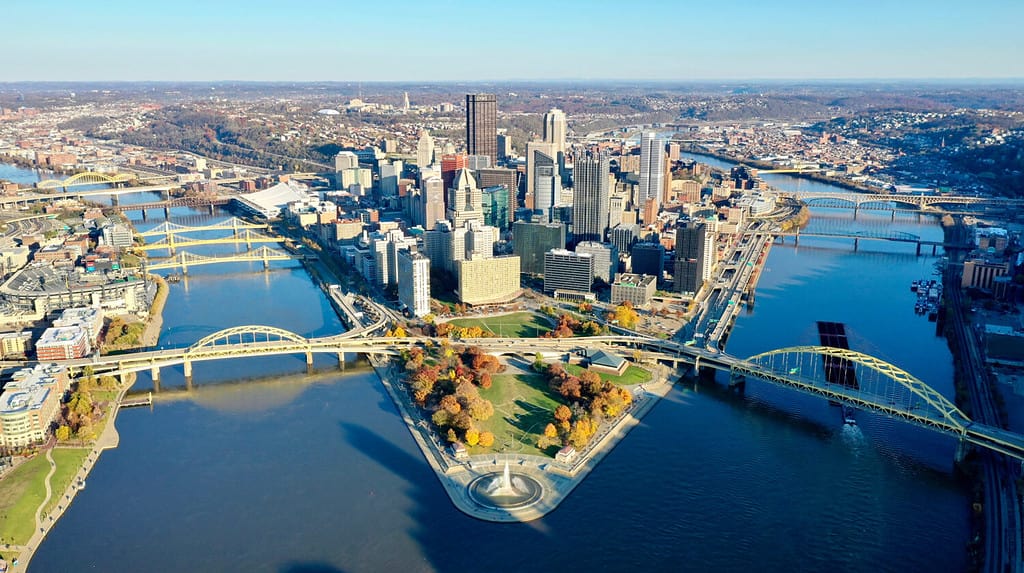
In Pittsburgh, the Allegheny River arrives from northern Pennsylvania and the Monongahela River from the south.
©Trucker from Pittsburgh/Shutterstock.com
The Allegheny River meets the Monongahela River to form the Ohio River in Pittsburgh. The Point State Park in downtown Pittsburgh is a popular spot to observe this confluence.
The Ohio River flows through Ohio, West Virginia, Kentucky, Indiana, and Illinois. The Ohio River joins the Mississippi River at the border of Illinois, Kentucky, and Missouri.
With the Mississippi River, the Allegheny waters make it all the way to the Gulf of Mexico.
What Are the Tributaries of the Allegheny River?

The Clarion River, one of the largest tributaries, is approximately 110 miles long.
©K Steve Cope/Shutterstock.com
The Allegheny River starts as a small stream in northern Pennsylvania but transforms into a large and mighty river thanks to its many tributaries.
- Clarion River is one of the Allegheny River’s largest tributaries. It flows into the river near the town of Parker in Pennsylvania.
- Kiskiminetas River flows through the western part of Pennsylvania before joining the Allegheny River at Freeport, PA.
- French Creek is another significant tributary, entering the Allegheny River near Franklin, Pennsylvania. It originates in New York and flows southward through Pennsylvania.
- Conewango Creek flows into the Allegheny River in Warren, PA.
- Redbank Creek merges with the Allegheny River in New Bethlehem, PA.
- Oil Creek was the site of the world’s first commercial oil well. It joins the Allegheny River near Oil City, PA.
- Mahoning Creek flows into the Allegheny River near Parker, PA, like the Clarion River.
- Tionesta Creek enters the Allegheny River near Tionesta, PA.
All these tributaries contribute to the river’s volume and play a role in the overall ecology and hydrology of the Allegheny River.
How Wide Is the Allegheny River?

The Alleghany Reservoir is one of the widest parts of the river.
©woodsnorthphoto/Shutterstock.com
Allegheny River’s width significantly varies along its course. It all depends on the location, flow rate, and the presence of islands or other geographical features.
On average, the width of the Allegheny River can range from several hundred feet to over a thousand feet (approximately 91 to 305 meters) in its wider sections.
However, it’s essential to note that these measurements are approximate and can always change over time due to natural processes and human activities. The river’s width is influenced by factors like rainfall, snowmelt, and the presence of dams or reservoirs along its course.
How Deep Is the Allegheny River?
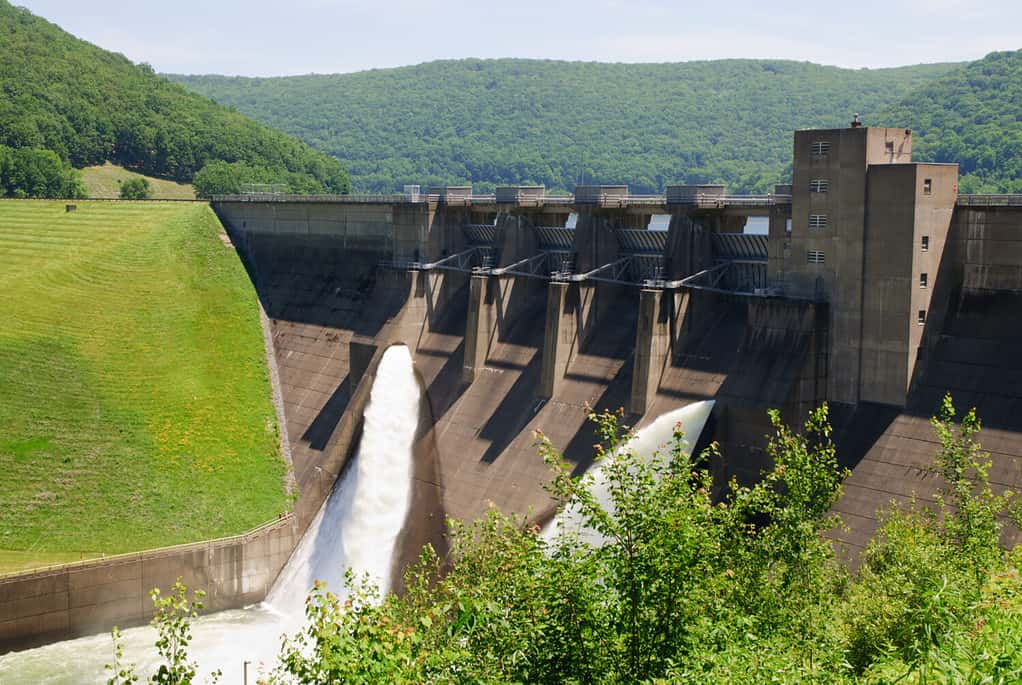
Every time the dam releases water, the depth of the Allegheny River will change.
©Jeffrey M. Frank/Shutterstock.com
The depth of the Allegheny River, like its width, can vary significantly along its course. The Allegheny River can have depths ranging from a few feet to over 20 feet (approximately 0.9 to 6 meters) in its deeper sections. However, these depths are not uniform, and there can be variations depending on the specific stretch of the river.
The river’s depth can also change seasonally, with higher water levels during increased rainfall or snowmelt periods and lower water levels during drier times. When dams release an inflow of water from the reservoirs, this will significantly influence the depth of the Allegheny River.
What Wildlife Live in and around the Allegheny River?

Conservation areas along the Allegheny Reservoir help protect the osprey’s nesting pairs and sites.
©Wang LiQiang/Shutterstock.com
The Allegheny River is home to diverse wildlife species. The region’s varied landscapes create a favorable environment for numerous animals.
- Fish: The river is home to various fish species, including smallmouth bass, walleye, muskellunge, northern pike, and catfish.
- Amphibians and Reptiles: The Allegheny River area is home to various amphibians and reptiles, including frogs, salamanders, turtles, and snakes.
- Invertebrates: The river supports a diverse aquatic invertebrate community, essential for the food web. This includes crayfish, freshwater mussels, and various aquatic insects.
- Birds: The riparian areas along the river provide habitat for many bird species. You can spot ospreys, great blue herons, waterfowl, songbirds, and various migratory species. Bald eagles are a common sight, especially during winter. In addition, multiple waterfowl stop around the river during migration.
- Mammals: Many mammals live near the Allegheny River, like the white-tailed deer, beavers, raccoons, river otters, muskrats, and mink. Larger carnivores like black bears and bobcats may also be present in the region.
Efforts to conserve and protect the natural habitats are essential to maintaining the health and biodiversity of the region. Conservation organizations, government agencies, and local communities work together to preserve the river’s ecosystems and wildlife. For example, recent conservation work helped significantly increase the bald eagle population.
What Activities to Do on and along the Allegheny River?

The Allegheny River can welcome any water activity.
©Piper VanOrd/Shutterstock.com
With 325 miles of length, the Allegheny River offers residents and visitors ample choice of outdoor activities.
Water Activities
- Boating: The river is an excellent place for boating, whether with a kayak, canoe, paddleboard, or motorized boat. Boaters can explore the river’s meandering channels, calm stretches, and scenic backwaters.
- Fishing: The Allegheny River is a perfect spot for anglers, as the river is known for its excellent fishing opportunities. Anglers can catch various fish species, including smallmouth bass, walleye, muskellunge, catfish, and more.
- Swimming: In the summer months, some sections of the river may be suitable for swimming and cooling off. It is always important to avoid swimming in the areas close to the dams as this can be extremely dangerous.
Land Activities
- Camping: Many campgrounds are located along the riverbanks, offering opportunities for camping and enjoying the outdoors. Whether tent camping or RV camping, there are options for everyone.
- Hiking: Explore the surrounding forests and trails that offer beautiful views of the river and its tributaries. In the fall, the area even boasts stunning fall foliage!
- Picnicking: Many parks and scenic spots along the river offer picnic areas to enjoy a meal with a view.
- Wildflower and Plant Identification: Visitors can explore the diverse flora along the riverbanks and learn about native plants and wildflowers.
- Historical Sites: Explore historical sites and landmarks along the river, including old settlements, forts, and industrial remnants that offer insights into the region’s history.
Wildlife Watching
- Birdwatching: The river and its wetlands attract various bird species, making it a prime destination for birdwatchers. You can spot bald eagles, ospreys, herons, and other birds.
- Wildlife Viewing: Keep an eye out for wildlife such as deer, beavers, river otters, and various other animals that call the river and its banks home.
Remember to check local regulations and safety guidelines when engaging in outdoor activities along the river.
Why Is the Allegheny River Famous?
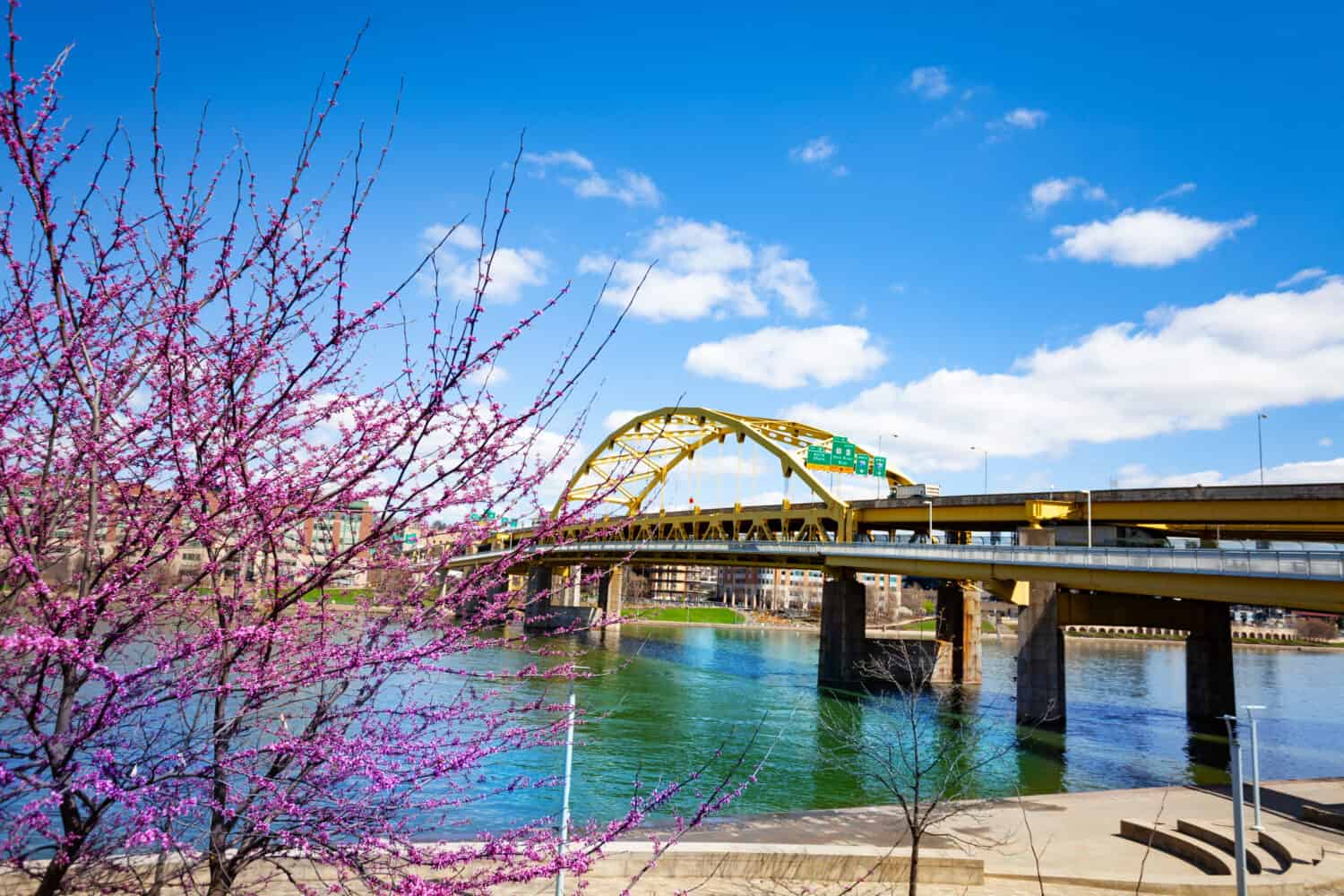
A lot of the events celebrating the river happen in Pittsburgh.
©Sergey Novikov/Shutterstock.com
The Allegheny River is famous for its rich history, cultural heritage, and significant economic impact on the regions it flows through.
History
The river and its surrounding areas have a long history of Native American settlement. Various Indigenous tribes, including the Seneca and the Haudenosaunee, inhabited the region for centuries before European exploration and settlement.
Later on, during the 18th century, the Allegheny River played an essential role in the French and Indian War (a conflict between British and French forces for control of North America). Fort Duquesne, located at the confluence of the Allegheny and Monongahela Rivers (modern-day Pittsburgh), was a strategic point in the war.
During the westward expansion, the Allegheny River served as a transportation corridor. It moved settlers, traders, and supplies into the Ohio River Valley and beyond.
Cultural Heritage
The Allegheny River was at the heart of the American Industrial Revolution in the 19th century. The region around Pittsburgh became an industrial powerhouse, with steel production, coal mining, and manufacturing thriving along the riverbanks.
The river has inspired artists, writers, and photographers over the years. Painters like George Hetzel and authors like Willa Cather have drawn inspiration from the natural beauty and industrial scenes along the Allegheny.
Nowadays, numerous towns and cities along the river have unique cultural identities tied to their riverfront locations. These communities often host festivals, events, and historical sites celebrating their heritage.
The photo featured at the top of this post is © Piper VanOrd/Shutterstock.com
Thank you for reading! Have some feedback for us? Contact the AZ Animals editorial team.






